This Pad Thai recipe is fast and easy to make with simple, authentic ingredients in under 30 minutes! Add shrimp, chicken, or tofu for a delicious vegetarian version. Video.
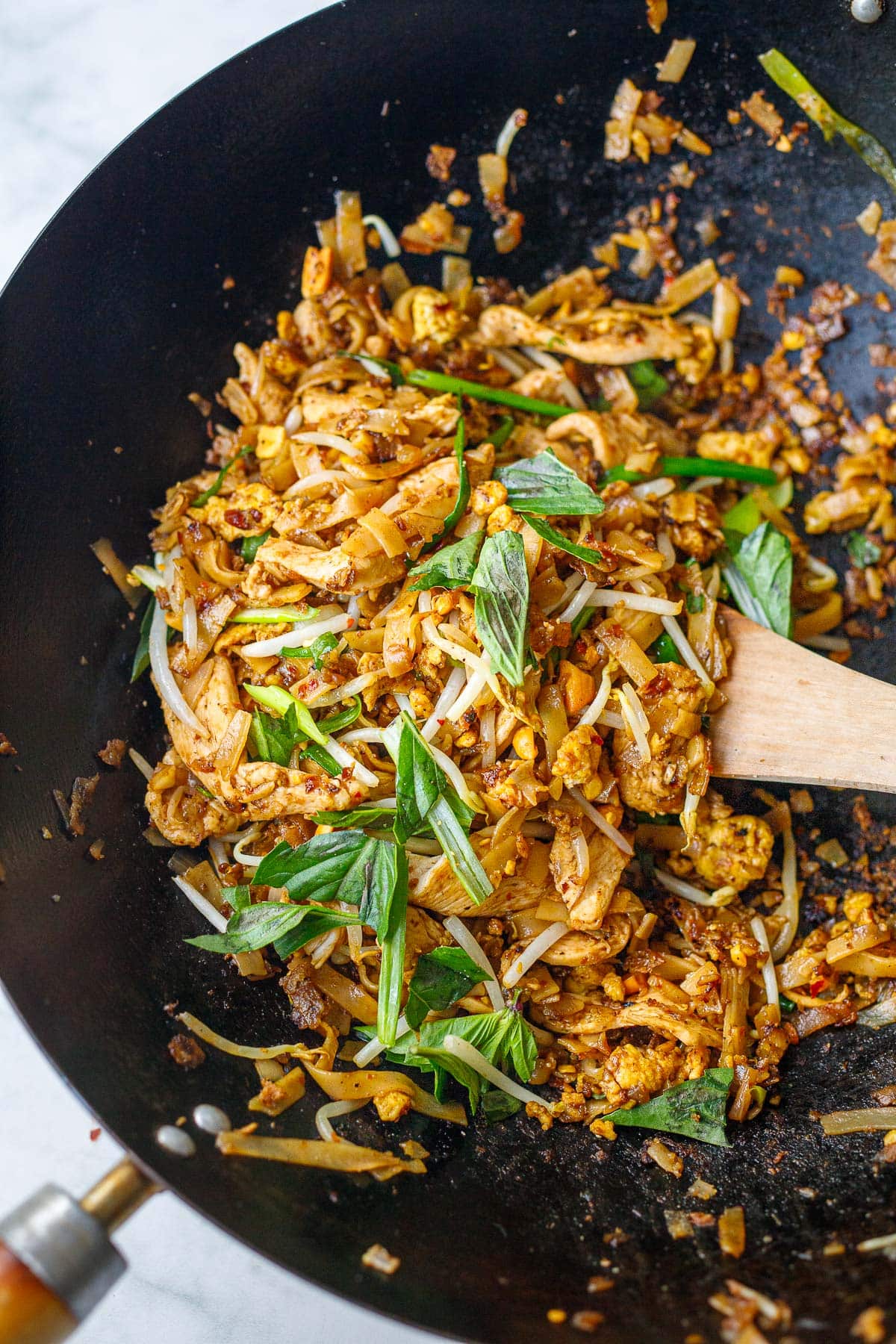
As a chef and caterer, I’ve cooked and eaten a lot of Pad Thai in my lifetime, both here and all throughout Thailand. We’ve captured the authentic flavor you’ll find in Bangkok while keeping the ingredients simple and the cooking fast and easy.
I may be biased, but I think this is the best Pad Thai recipe around-not overly sweet like many Americanized versions. You’ll find no ketchup or peanut butter in this recipe. But don’t take my word for it; just read all our great reviews!
But first, What is Pad Thai?
Pad Thai is a popular stir-fried noodle dish from Thailand made with rice noodles, shallot, garlic, scrambled eggs, and a protein, typically chicken or shrimp, in a flavorful, tangy, umami Pad Thai Sauce. It’s served with fresh bean sprouts, crushed peanuts, scallions and lime.
Why this Pad Thai Recipe is the Best!
- Balanced Flavor. Pad Thai sauce is a delicate balance between umami, sourness, and sweetness. Most American versions are way too sweet; this one is just right.
- It’s adaptable! This recipe can be made with chicken, shrimp, tofu and /or veggies! Gluten-free, vegetarian and vegan-adaptable.
- Quick and Easy– Once the ingredients are prepped, this takes 15 minutes of cooking time!
- Simple Ingredients. These accessible ingredients can be found in most grocery stores.
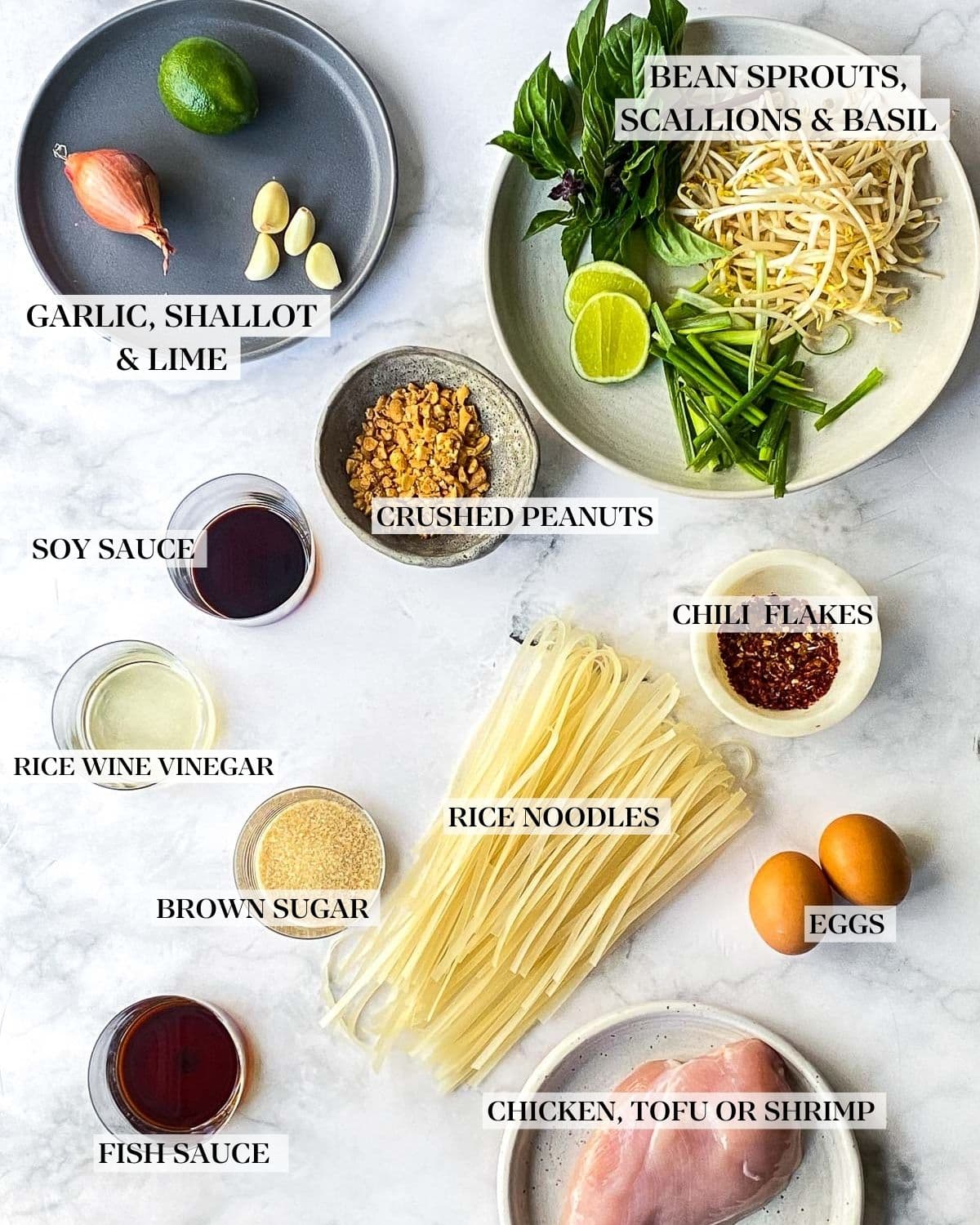
Pad Thai Ingredients
- Rice Noodles: Pad Thai is typically made with noodles called “rice stick”, which are rice noodles that are about 1/4 inch wide. Some brands are better than others- many fall apart when stir-frying. I have had the best luck with Thai Kitchen rice noodles. Make sure to soak the noodles, rather than boil, to prevent breaking.
- Protein: Add thinly sliced chicken breast, shrimp, or crispy Tofu, or leave out the protein and add stir-fried veggies. Extra firm tofu works best.
- Eggs: Traditional pad thai has scrambled eggs, vegans can leave this out.
- Garlic cloves and shallots: Shallots really elevate Pad Thai. I highly recommend shallots over onions if possible. Some versions use ginger, but in Thailand, they generally don’t.
- Fresh Lime Juice: adds acidity.
- Garnishes: The garnishes make Pad Thai, adding texture and flavor. Sliced green onions, crushed roasted peanuts, fresh bean sprouts, Thai chili flakes and lime wedges and if available, Thai basil, all elevate!
Pad Thai Sauce Ingredients
The secret to the best Pad Thai Sauce is the perfect balance of salty, sweet and sour. Our sauce has delicious umami and depth, while not being overly sweet with a lovely tang. Letting the sauce caramelize in the wok for just a few seconds, adds a lovely smokiness.
- Fish Sauce – Fish Sauce can vary in degrees of saltiness from brand to brand. I like Red Boat Fish sauce, or Thai Kitchen Fish Sauce (found at most grocery stores) best for this recipe. (*Vegans can sub our vegan fish sauce and soy sauce.) If you are new to fish sauce, keep in mind, it has a little “funk” to it. You can start off lighter and replace the rest with soy sauce.
- Tamarind Water or Rice Wine Vinegar – authentic Pad Thai is made with tamarind water and lime juice to give it the sour component, but feel free to use Rice Wine Vinegar and lime to keep things simple here. See recipe notes for using tamarind.
- Sugar – In Thailand, it is traditional to use palm sugar but we use brown sugar, coconut sugar or regular cane sugar to add sweetness. Note: Do not be tempted to cut back on the sugar, the Pad Thai will be too sour.
- Soy Sauce – adding a little soy sauce adds even more depth. You can also use gluten-free liquid aminos!
How to make Pad Thai (easy Instructions)
Step 1: Soak the rice noodles. Pour boiling water over the rice noodles let them soak until they are soft and pliable (about 5-6 minutes) but not overly soft; drain.
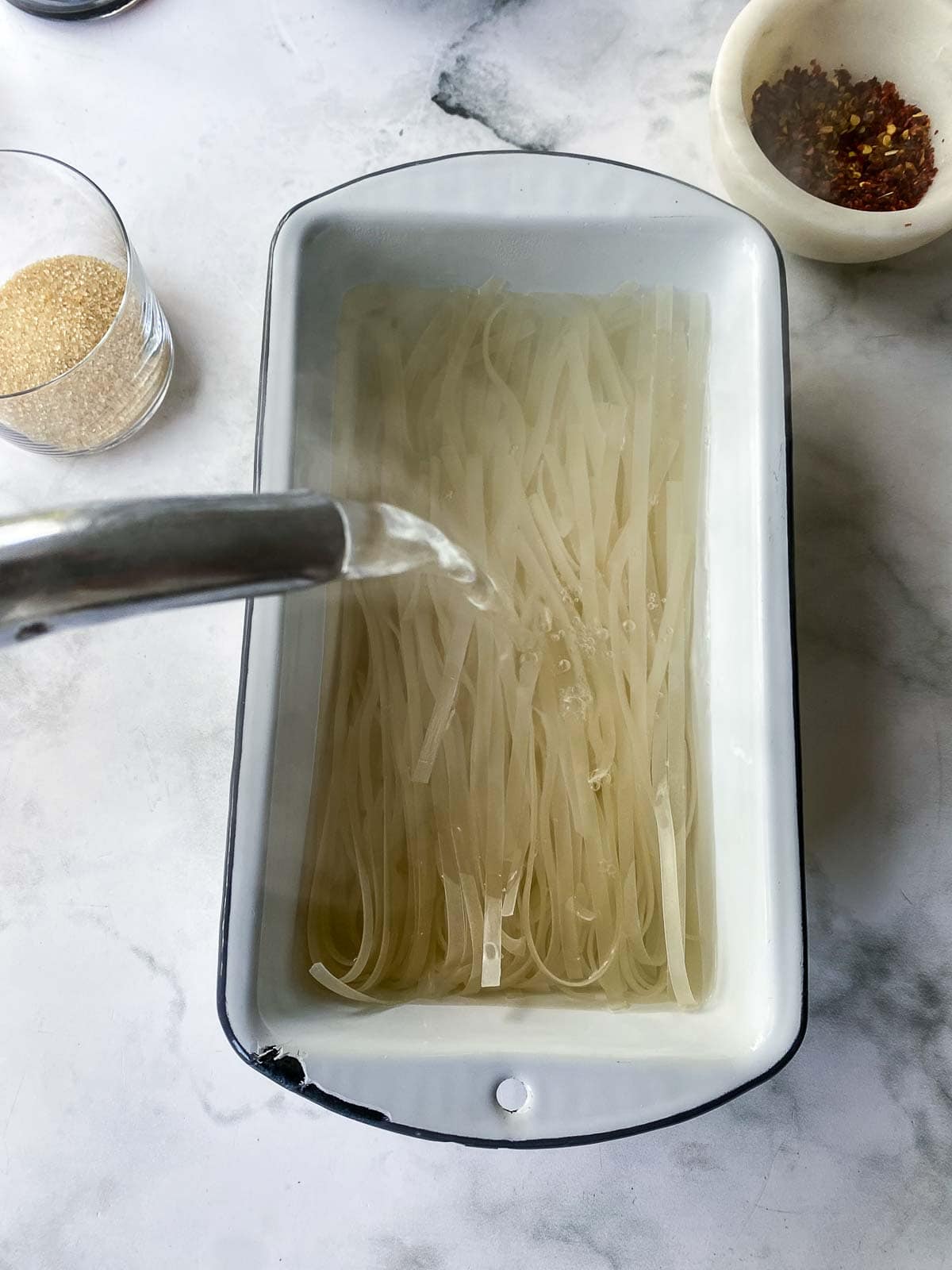
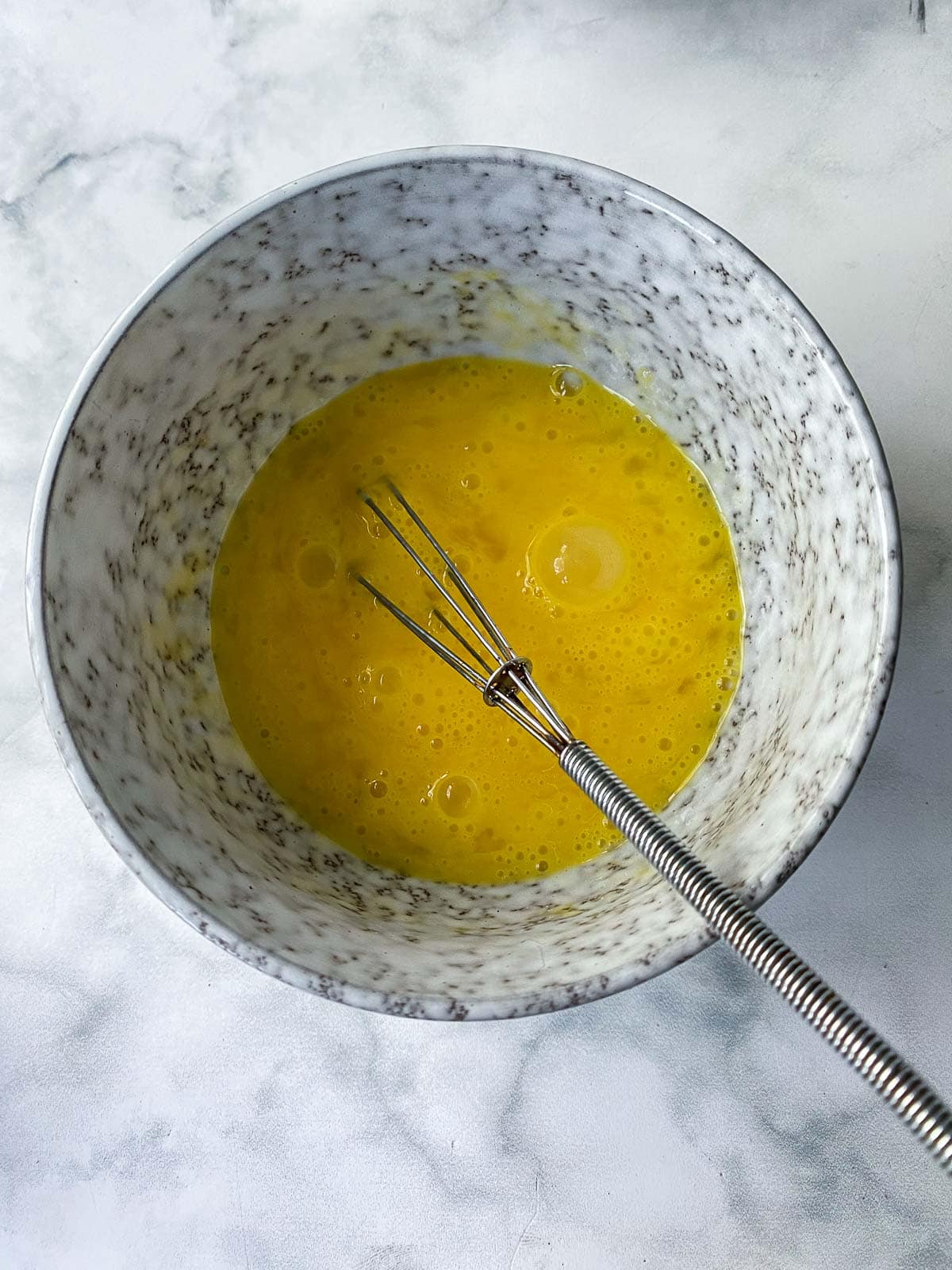
Step 2: Whisk the Eggs. Whisk the eggs in a medium bowl with a pinch of salt. Set aside by the stove.
Step 3: How to make Pad Thai Sauce. Whisk the pad thai sauce ingredients together in a small bowl- keeping in mind, there is a delicate balance between salty, sour and sweet, so if you alter one ingredient, you may need to adjust the others. Make sure the sugar completely dissolves.
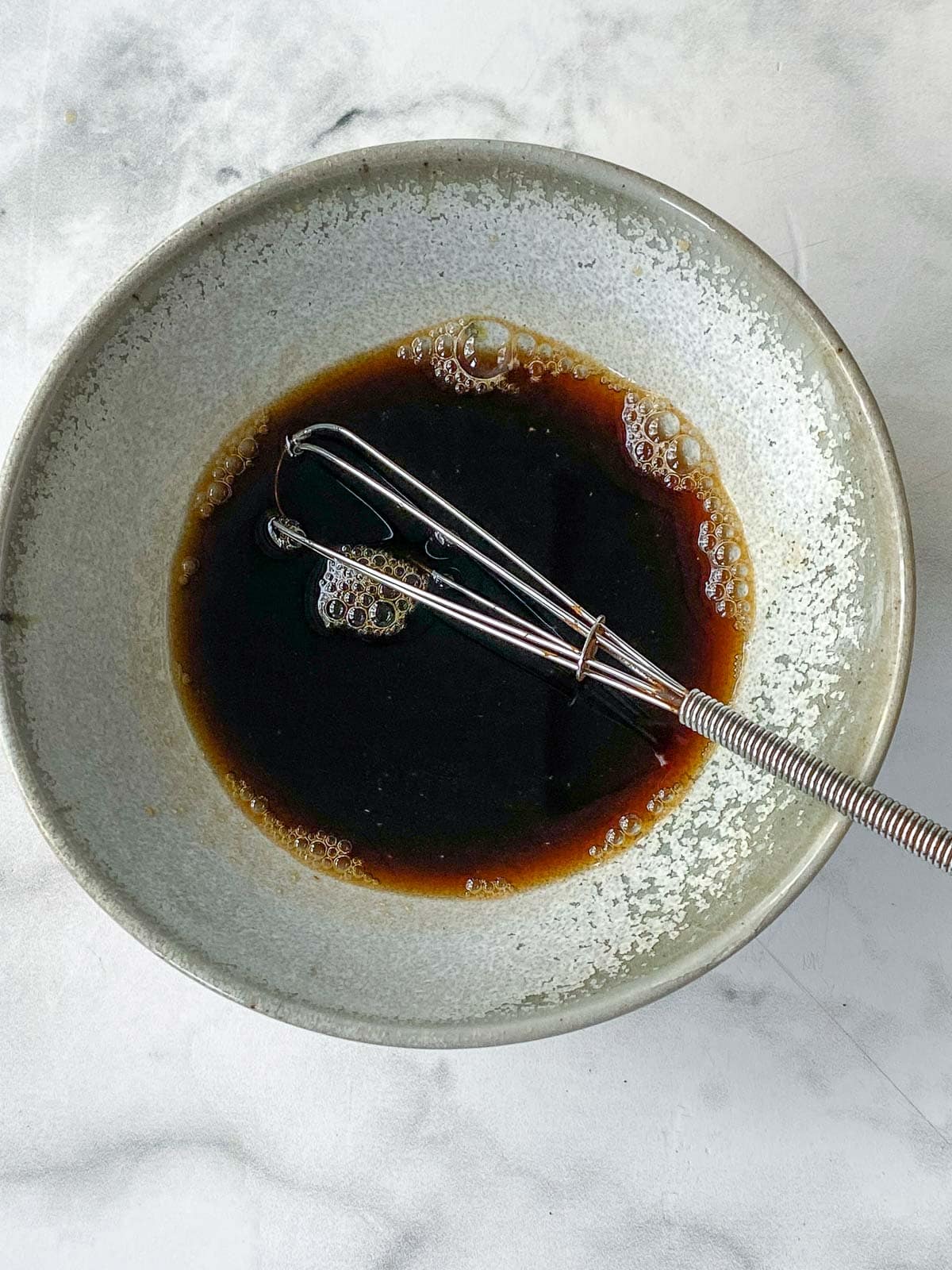
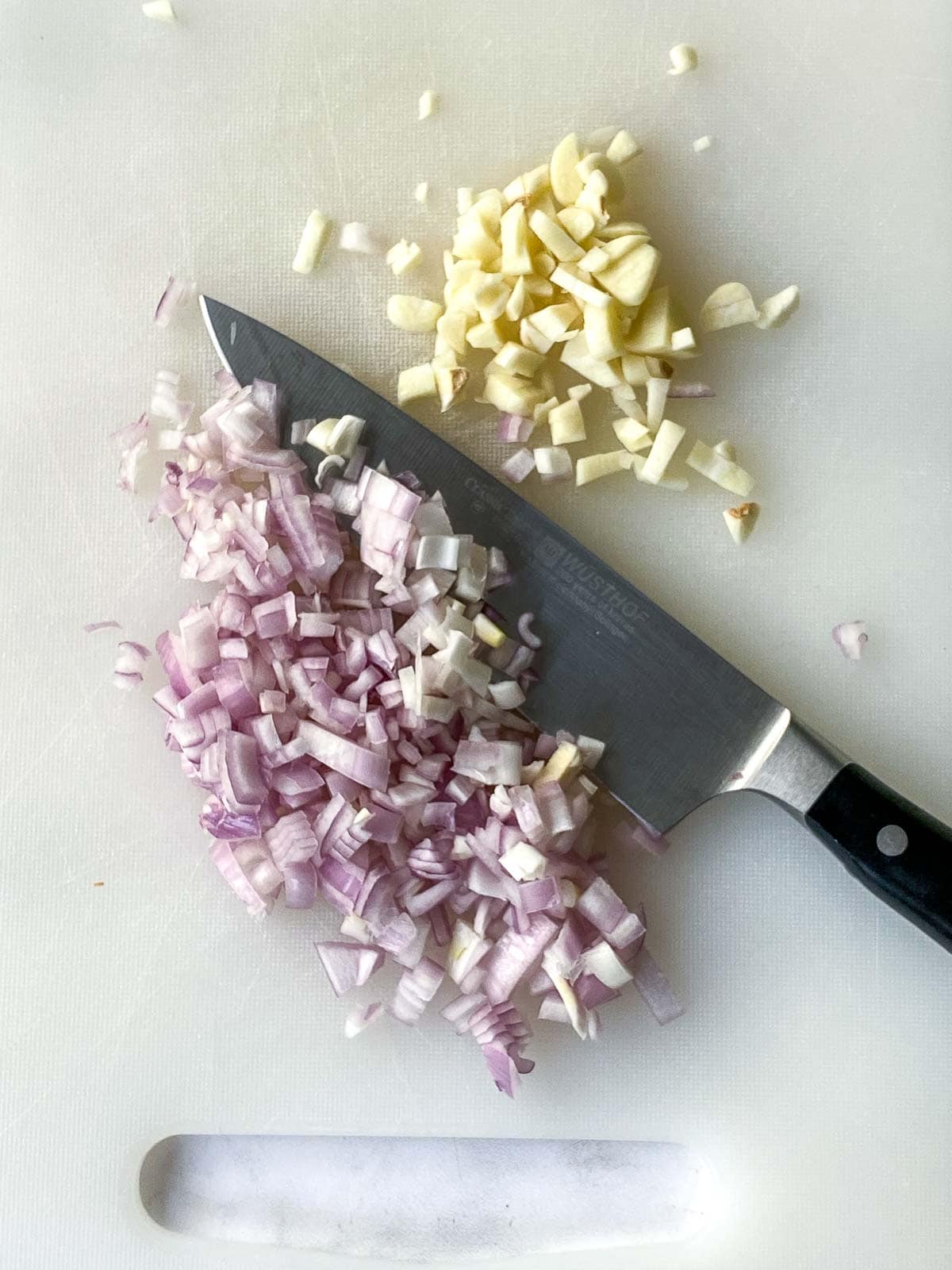
Step 4: Prep the Protein & Veggies. Chop the shallot and garlic finely and set aside. Slice chicken thinly across the grain (or peel and devein shrimp). If adding veggies, chop or slice them small, so they cook quickly in the wok.
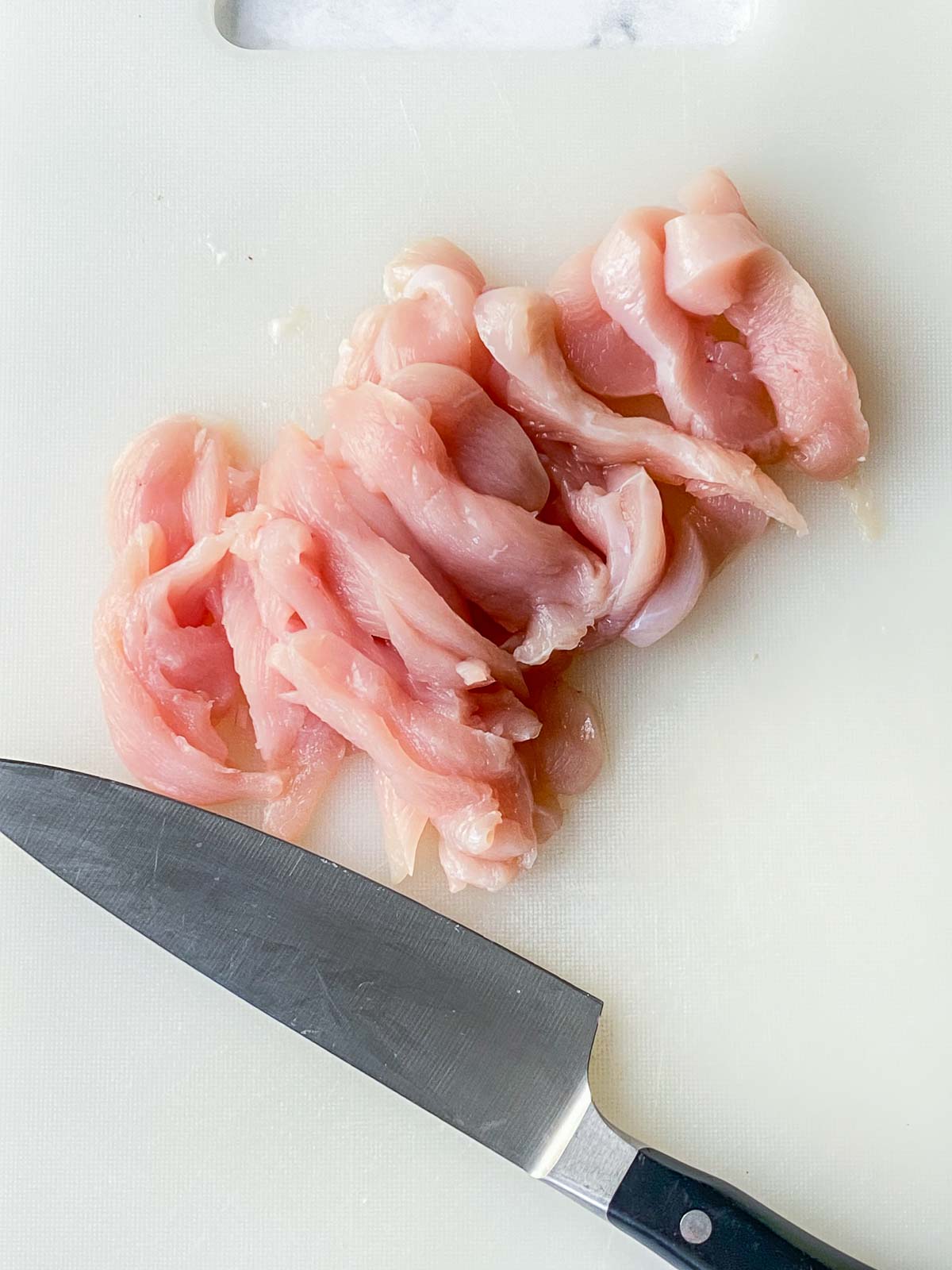
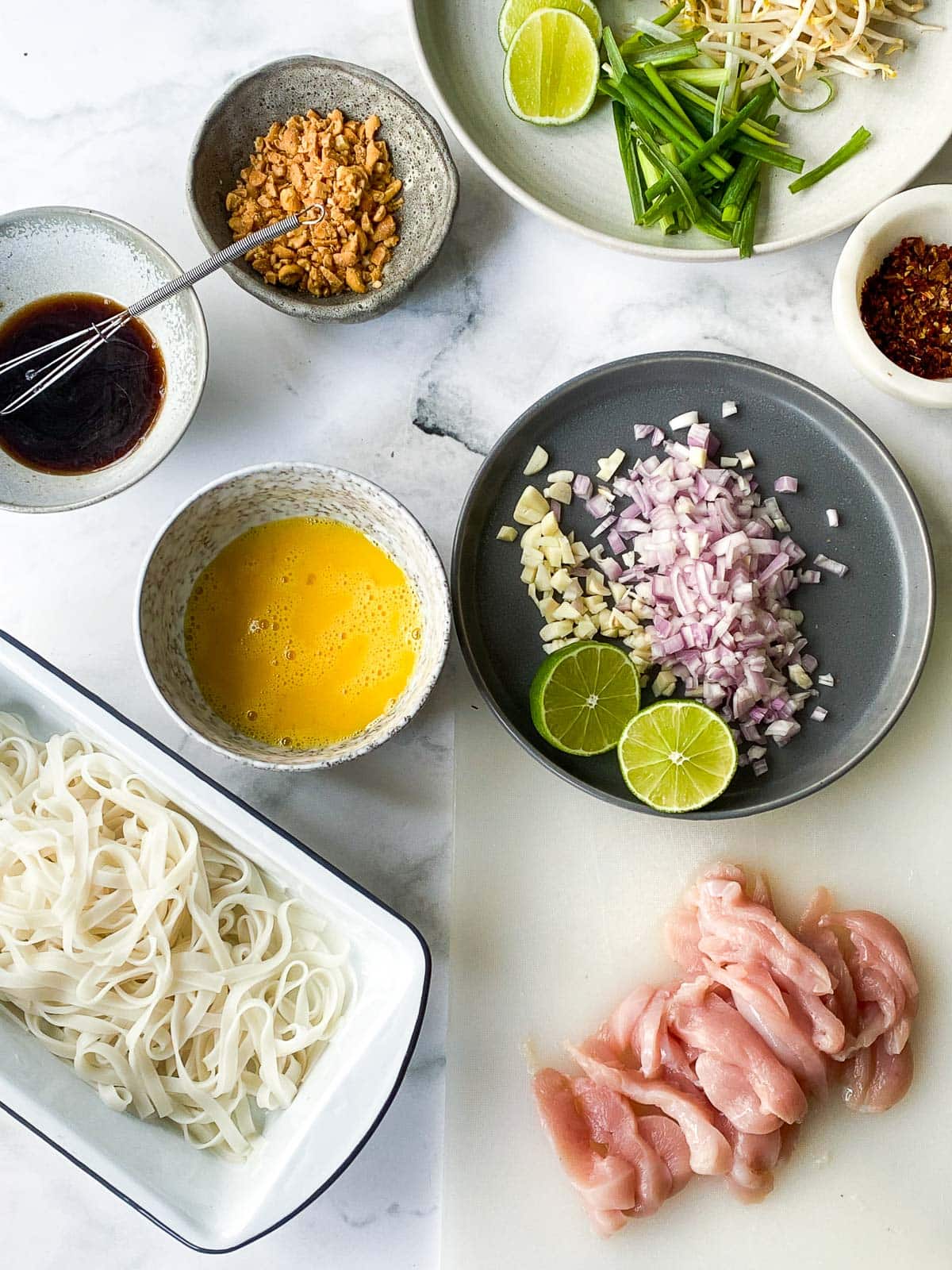
Step 5: Prep all your garnishes and have everything ready to go by the stove, keeping in mind the stir fry part will go quickly!
Step 6: Stir Fry! Season the protein with salt and pepper, and stir fry in a carbon steel wok until just cooked through and set it aside. If adding veggies, stir-fry these now and set aside as well.
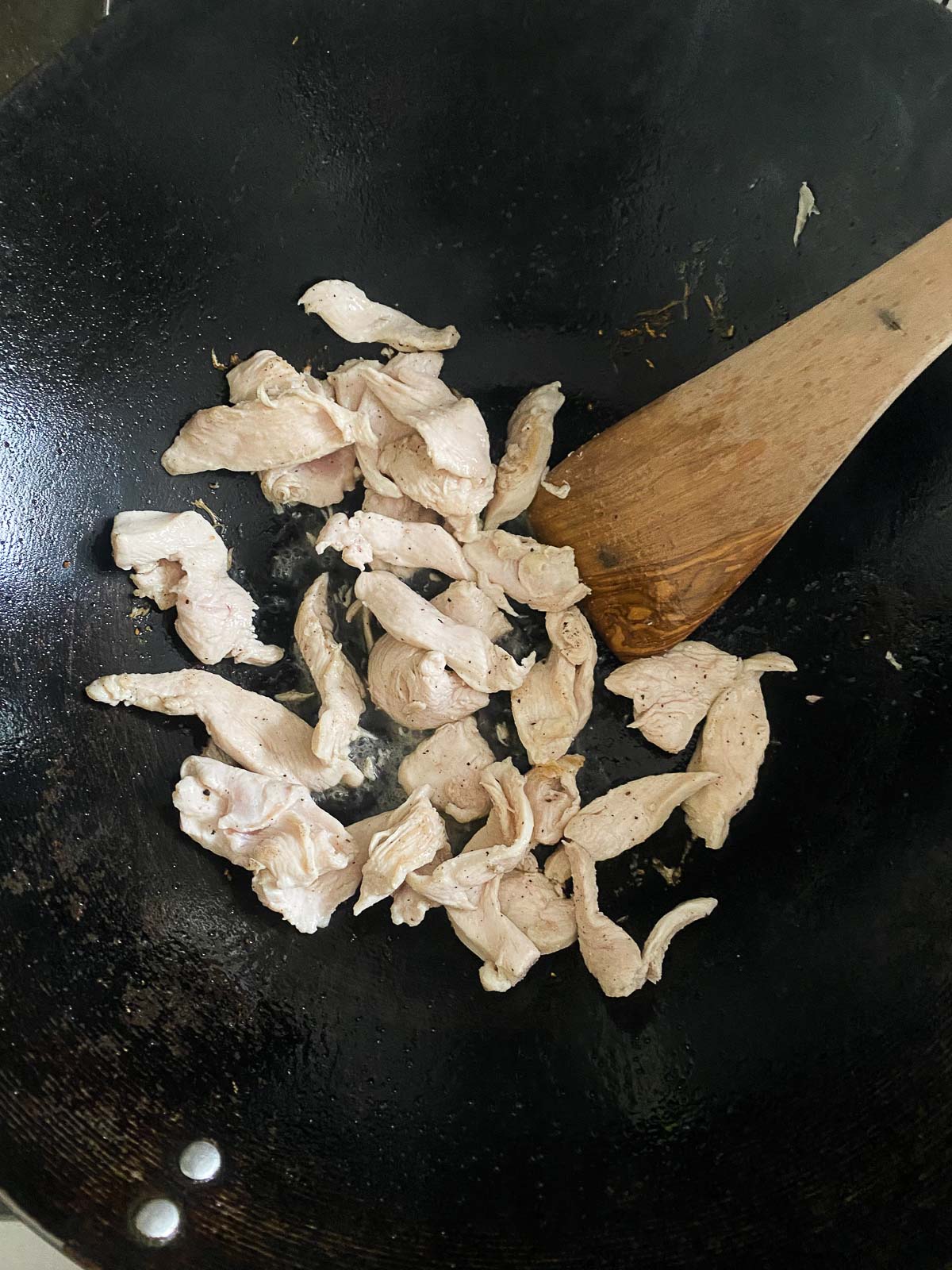
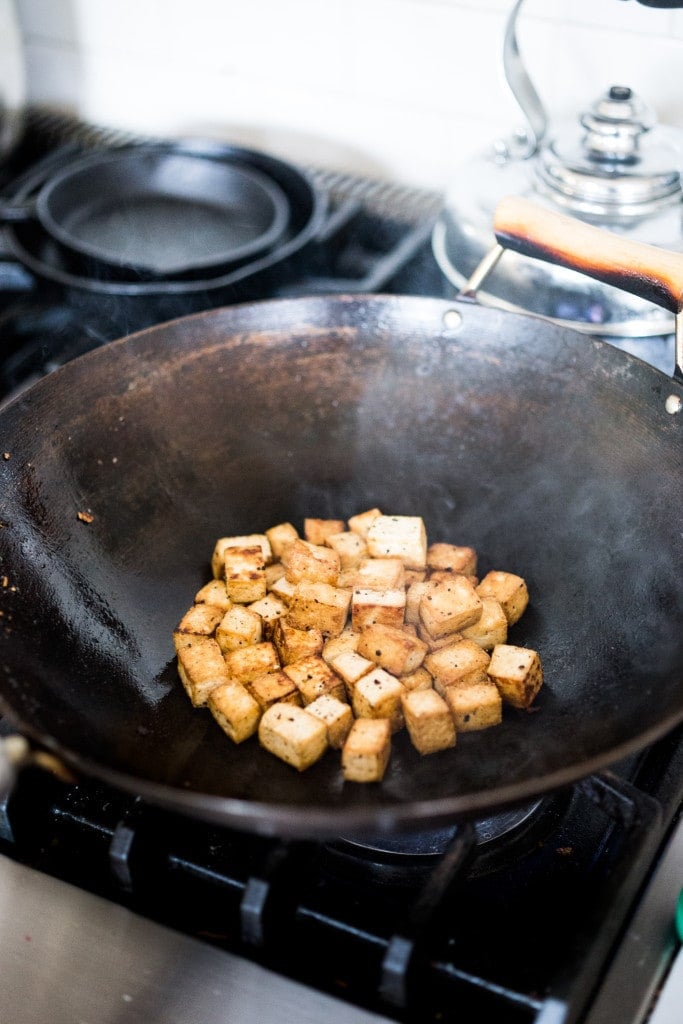
Add more oil to the wok and stir fry the garlic and shallots for just a couple minutes, scoot them over, add more oil if needed, and add the whisked the eggs, scrambling and breaking to bits.
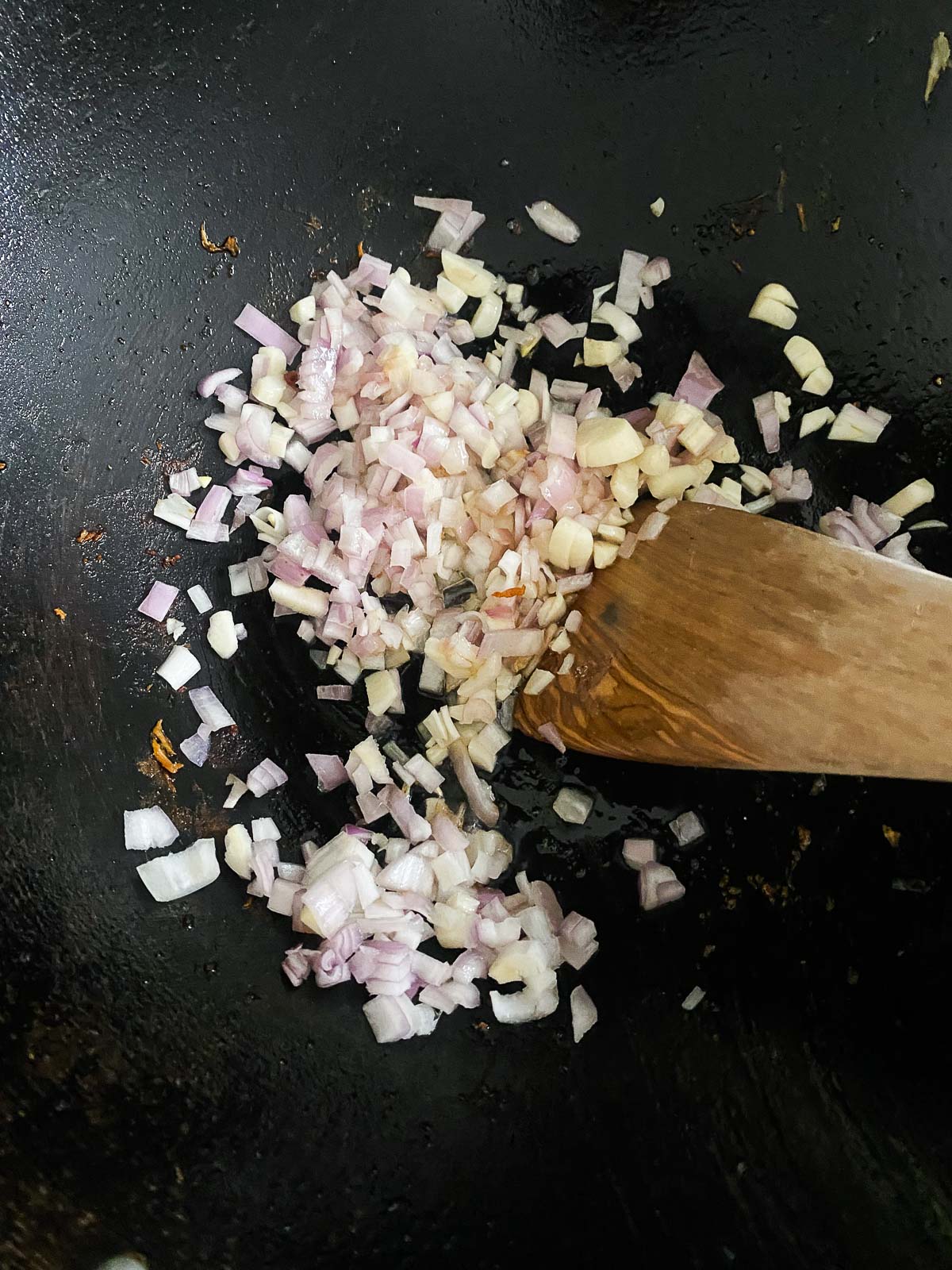
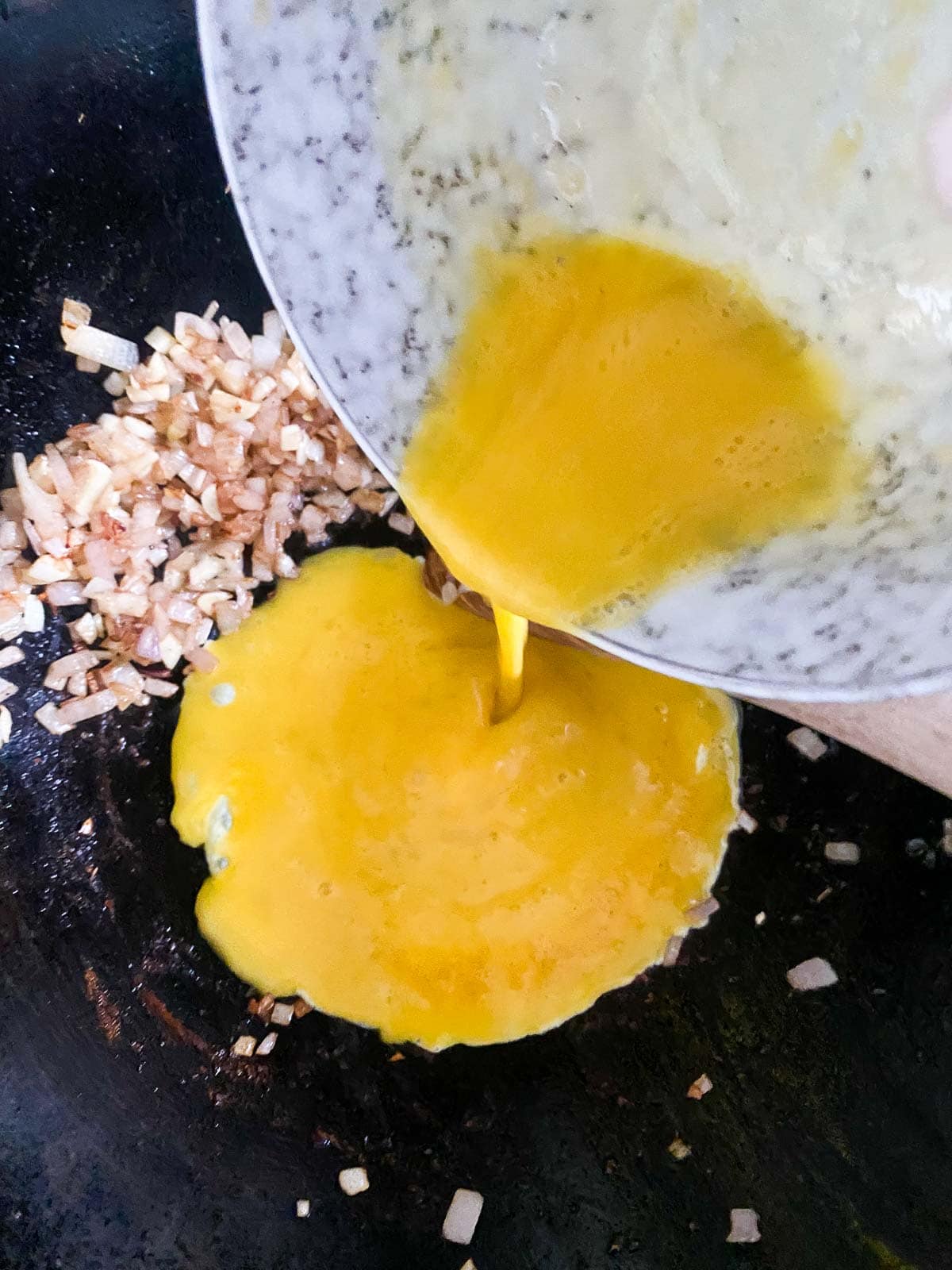
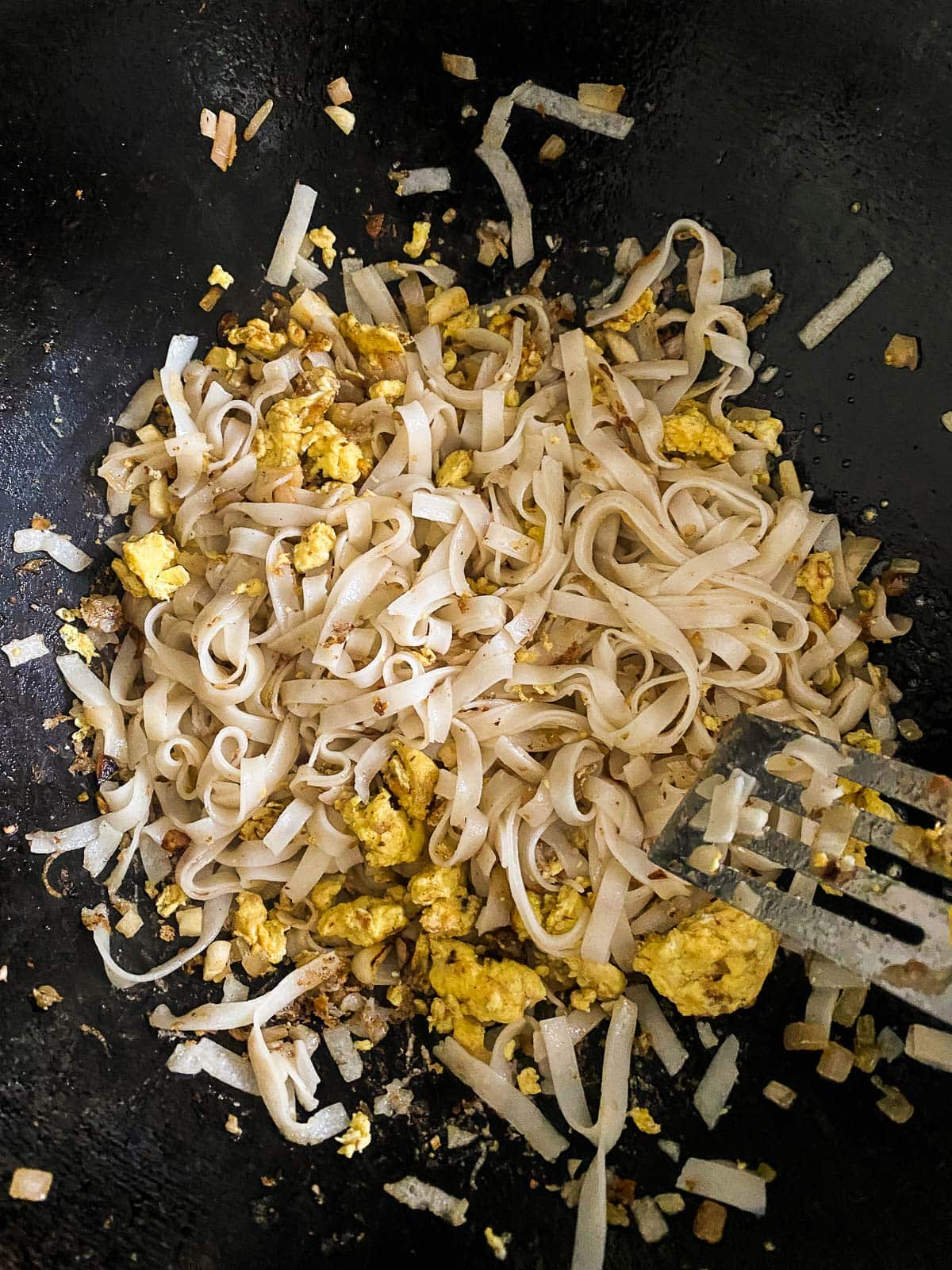
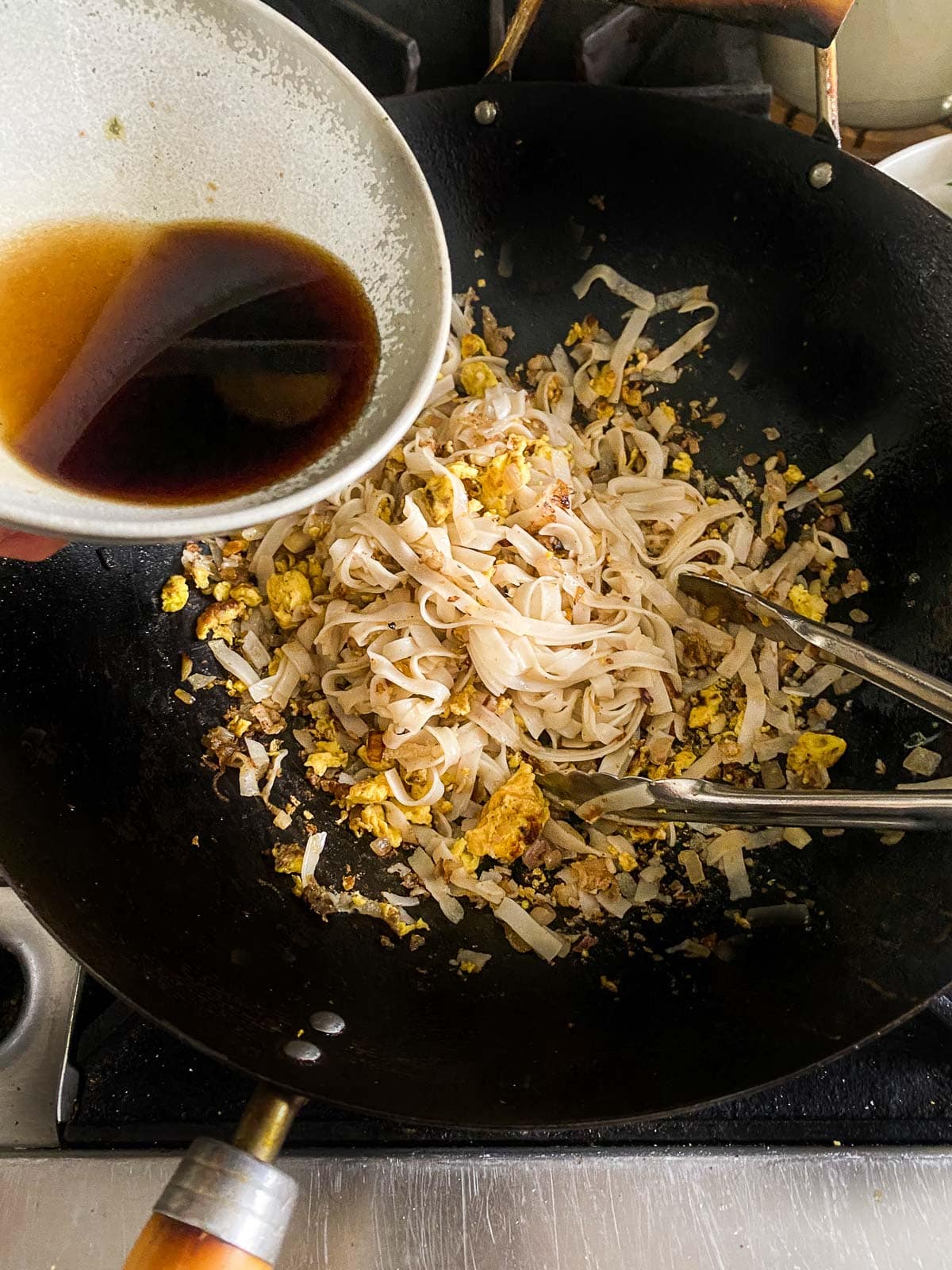
Scoot the eggs over and add more oil and stir fry the noodles, letting the noodles get a little crispy! Turn your hood on and pour in the Pad Thai Sauce. Let the sauce caramelize for 30 seconds, until you smell the sugar caramelizing. This will add great flavor!
Add back in the cooked protein and veggies, with some of the bean sprouts and scallions. Add a squeeze of lime.
*Taste and adjust salt, lime or sugar to taste. Find the perfect balance. See FAQ’s for troubleshooting the flavors.
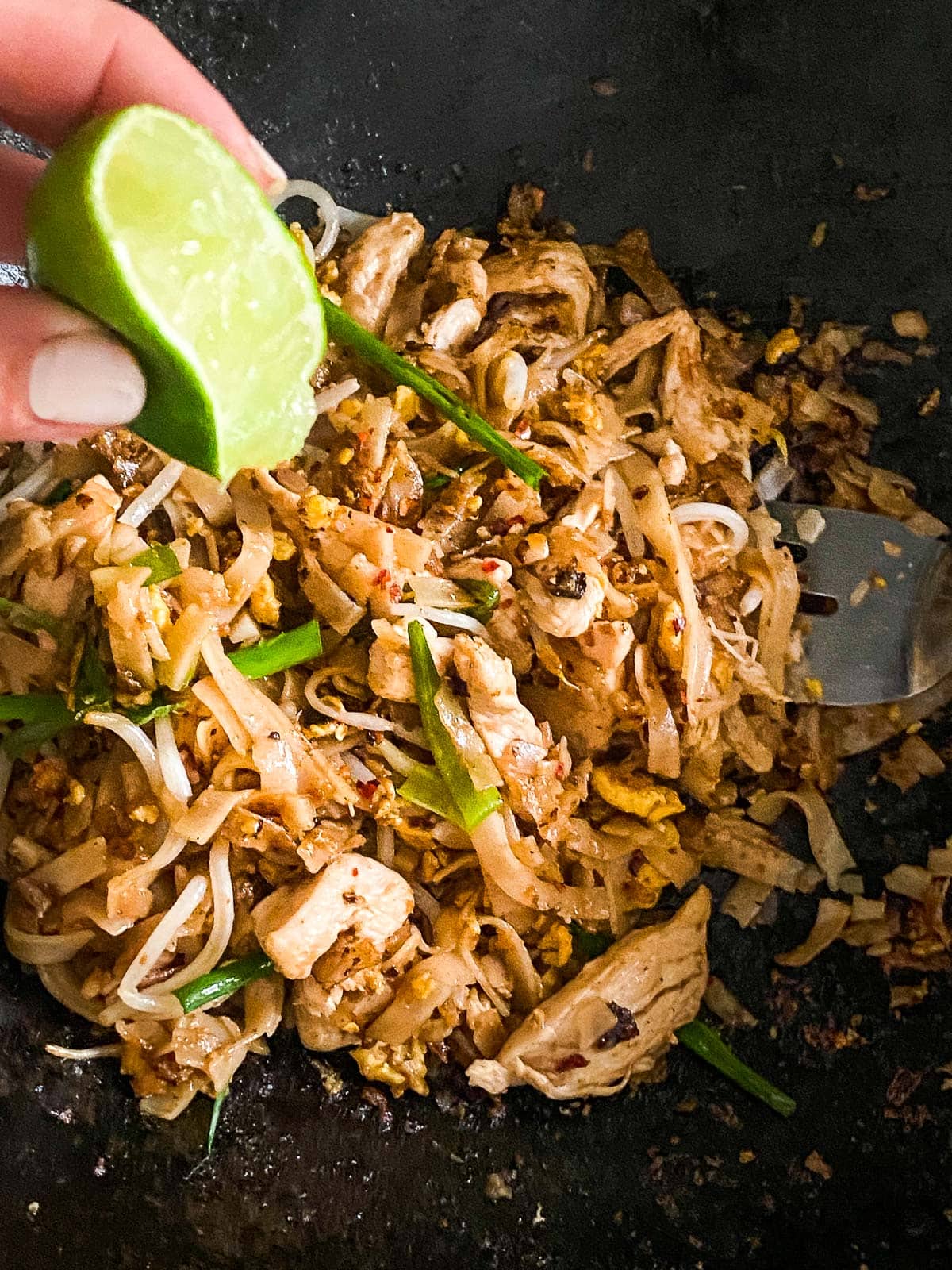
Step 7: Serve. Divide between 2-3 bowls and garnish with fresh bean sprouts, lime, wedge, crushed peanuts, chili flakes, scallions and basil. For extra heat, serve it with our chili garlic sauce!
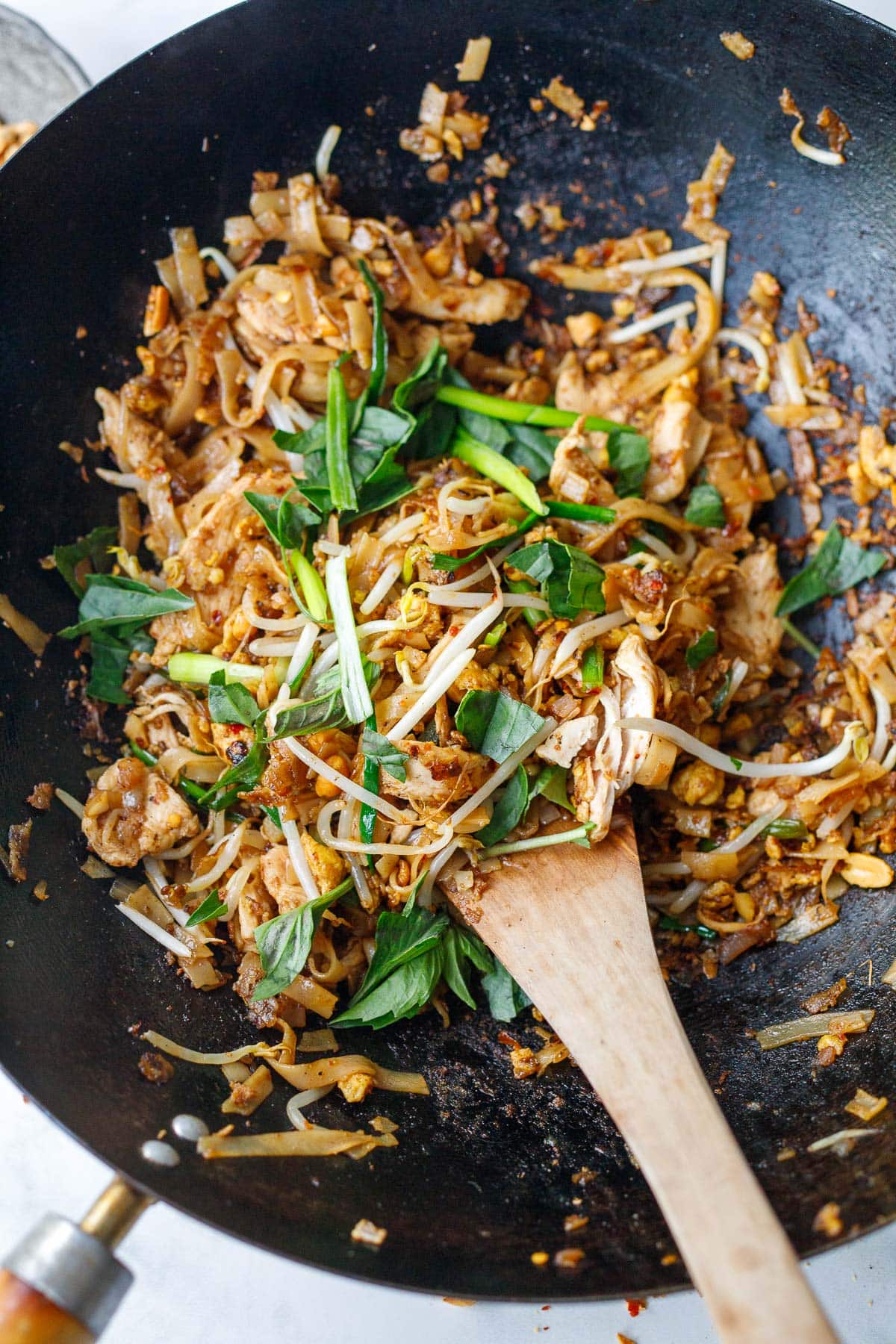
Pad Thai Noodle Tips
- Read the whole recipe through before you give it a go.
- Prep everything first, then place it near the stove. Cooking goes very fast here!
- Cut chicken very thinly to cut down on cooking time. Remember to cut across the grain, into ⅛ -¼ thin strips about two inches long.
- To lower calories, poach the chicken in a little salted water, until cooked through which just takes a couple of minutes. Then set it aside.
- Use shallot. Shallot adds so much flavor here- much more so than onion.
- Crispy noodles. Crisp up the rice noodles in the pan before adding the sauce.
- Let the Pad Thai sauce caramelize in the wok, before turning off the heat. This is the secret to the best flavor- a smoky sweetness we all crave!
Pad Thai Don’ts
- Please do not add ketchup or peanut butter. This is not authentic and takes away from the dish.
- Don’t use white vinegar instead of rice vinegar. White vinegar tastes way more acidic and it will be overly sour.
- Don’t skip the sweetener. you will lose the balance of the dish. You will end up with fishy, overly sour, salty Pad Thai that tastes terrible. TRUST ME.
- Don’t make too big of a batch. The noodles are stir-fried. You want the noodles to get slightly crispy in the pan, and the sugars to caramelize, giving them that incredible smoky flavor- this is difficult to achieve if making huge batches.
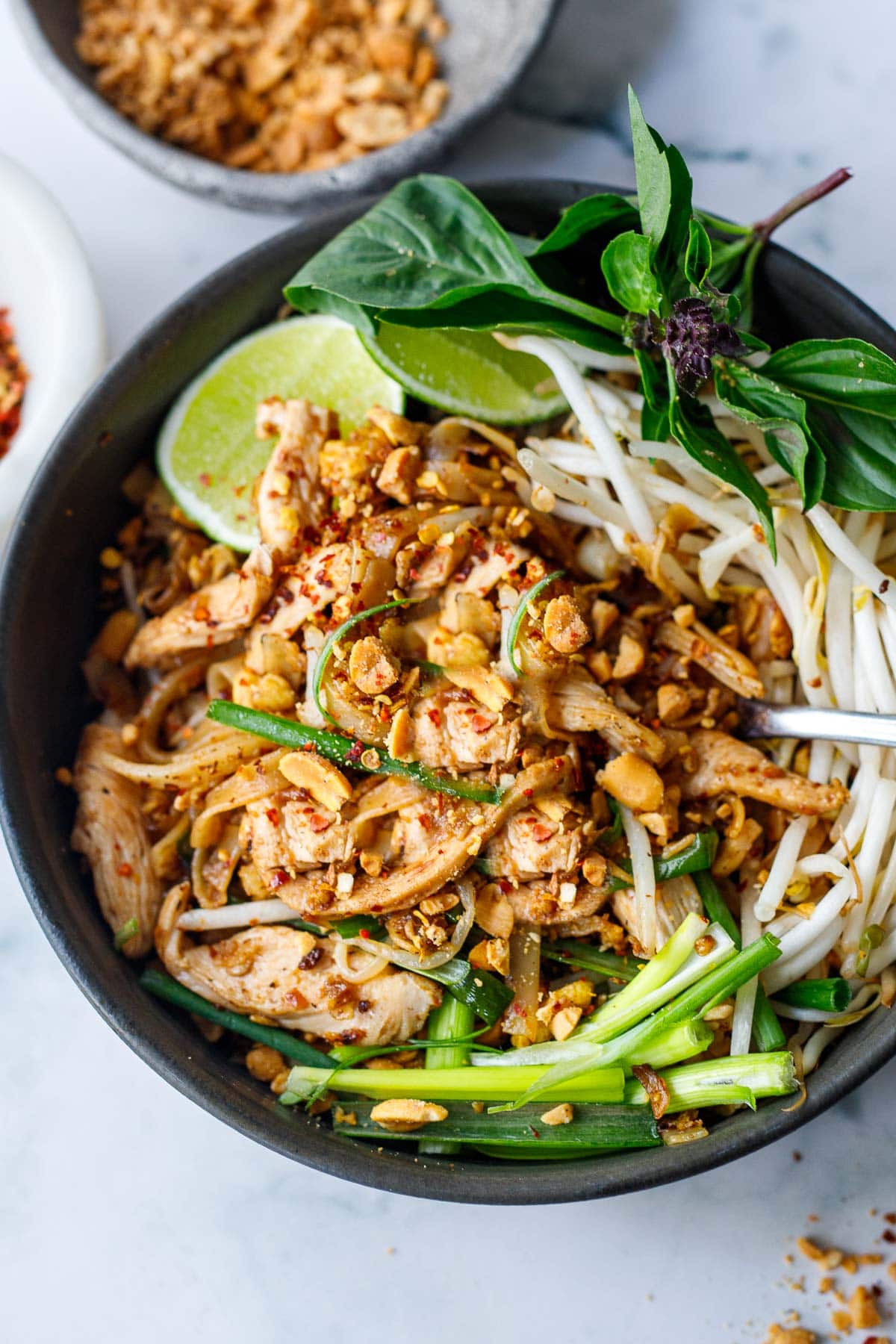
Serving Pad Thai Noodles
- Serve Pad Thai with lime wedges.
- Add fresh bean sprouts.
- Sprinkle with crushed roasted peanuts (or try this amazing Peanut Chili Crunch!)
- Add chopped scallions or Thai basil.
- Serve with Thai chili flakes, sriracha or chili paste for extra heat.
Storing Homemade Pad Thai
Pad Thai is best served right after it is cooked. Leftovers will last up to four days in an airtight container in the refrigerator. Reheat pad Thai in a skillet or wok, lightly stir frying.
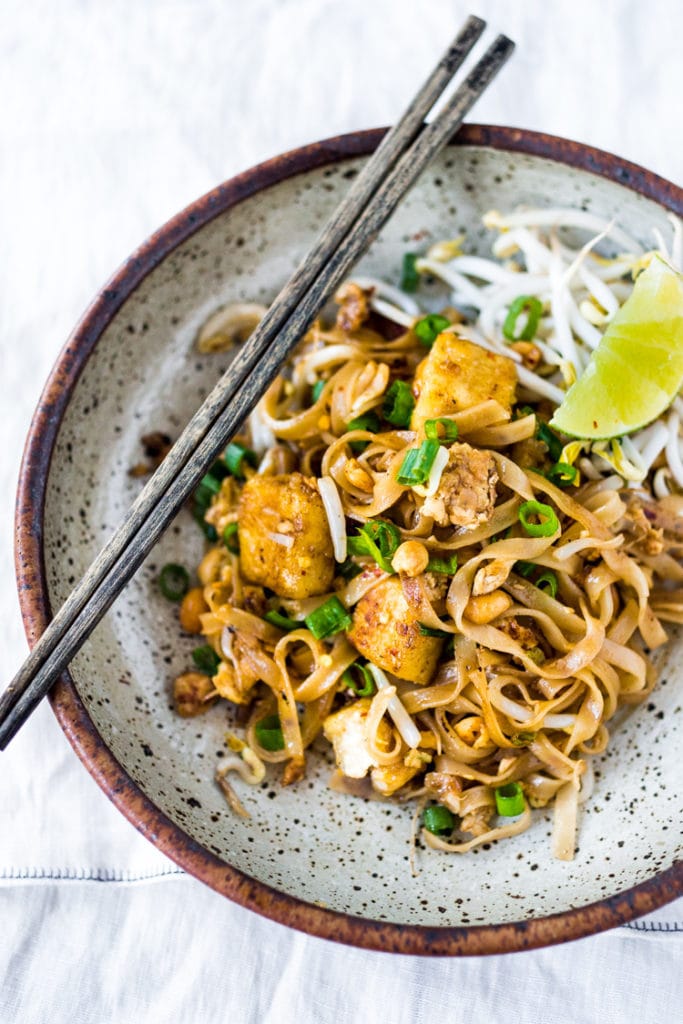
Pad Thai Recipe FAQs
Yes, Pad Thai can easily be made vegan. Use vegan fish sauce or soy sauce and crispy tofu as the protein, and leave out the eggs.
The secret to the best Pad Thai is not overcooking the rice noodles, using a very hot wok, cooking in smaller batches so rice noodles can caramelize, and having the perfect balance of flavors- not too sweet, not too sour, and not too salty.
Peanut oil adds the best flavor, while avocado and coconut oil both have a high smoke point. Both work well here. Any neutral high heat oil will work.
Any quick-cooking vegetables that can be cooked in a wok can be added to Pad Thai- asparagus, green beans, matchstick carrots, bell pepper and bok choy to name a few. Feel free to add steamed broccoli too!
Try adding a little more brown sugar and vinegar to balance it.
Add a little more brown sugar to balance it. White vinegar will do this- so always use rice wine vinegar, tamarind water or lime, which are all less acidic.
Add more acid ( rice vinegar, tamarind water or lime juice) to balance it.
What to serve with Pad Thai!
I hope that after you make this, you’ll think this is the best Pad Thai recipe you’ve ever had too! 😉 Haha! Let me know in the comments below! 🙂 Here are more of my favorite Fast, Easy Dinner Ideas!
Happy weekend.
xoxoxo
PS. It is my hope that through cooking, we not only learn new ingredients and techniques but also learn more about the culture and people from which the food we make originates. Cooking can be a way of celebrating all our unique and beautiful differences. I’d like to believe expanding our repertoire in the kitchen can also expand our hearts.
More Favorite Thai Noodle Dishes!
Love Thai Cuisine? Try…
- 33+ Easy Thai Recipes!
- Authentic Tom Kha Gai (Thai Coconut Chicken Soup)
- 30-Minute Thai Green Curry
- Thai Larb Salad
You may also love this Malaysian Char Kway Teow or Chickpea Curry!
More from Feasting At Home
How to make Pad Thai Noodles | Video
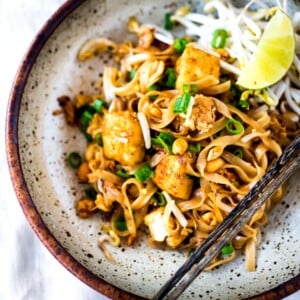
Easy Pad Thai (Chicken, Tofu or Shrimp)
- Prep Time: 15 mins
- Cook Time: 15 mins
- Total Time: 30 minutes
- Yield: 2 1x
- Category: Main
- Method: stir-fried
- Cuisine: Thai
- Diet: Vegetarian
Description
An easy, 30-minute recipe for Pad Thai made with rice noodles, your choice of chicken, shrimp or tofu, scrambled eggs, and an incredible “not too sweet” Pad Thai Sauce. Makes 2 large servings. Watch the video!
Ingredients
- 4 ounces rice noodles
- 3 tablespoons peanut oil, divided ( or use avocado oil, or coconut oil)
- 8 ounces chicken breast, tofu or prawns (peeled and deveined)
- salt and pepper to taste
- 1 large shallot, finely diced (much better than onion here)
- 4 fat garlic cloves, roughly chopped
- 2 eggs, whisked with a fork with a generous 3-finger pinch salt if vegan, leave it out)
- 1 lime
- 1 1/2 cups bean sprouts
Pad Thai Sauce:
- 3 tablespoons fish sauce (see notes- or use vegan fish sauce)
- 3 tablespoons brown sugar (or coconut sugar, palm sugar, or regular sugar) see notes
- 3 tablespoons of rice wine vinegar (or tamarind water– see notes) do not sub white vinegar, it will be too sour.
- 2 teaspoons soy sauce (or GF liquid aminos like Braggs)
Garnish:
- lime wedges, fresh bean sprouts, chili flakes, chopped scallions, roasted peanuts, Thai basil
Instructions
- Soak the rice noodles. Place rice noodles in a shallow pan and cover with boiling water for 4-7 minutes, stirring occasionally (so they don’t stick together) until al dente; drain, rinse with cold water to stop cooking. They don’t have to be totally soft, just bendy and pliable.
- Whisk the two eggs in a bowl with a fork and add a generous, 3-finger pinch of salt. Set aside.
- Make the Pad Thai Sauce: whisk fish sauce, rice vinegar, brown sugar and soy sauce. (see notes) in a small bowl. Set aside.
- Prep the protein. Chicken: slice chicken into very thin strips and season with salt and pepper. Crispy Tofu: Blot tofu with paper towels pressing down firmly. Cut tofu into ¾ inch cubes, sprinkle with salt and pepper, and for extra crispy, dredge in a little corn starch. Shrimp: season with salt and pepper.
- Cook the protein: Heat 1 tablespoon oil in a large saucepan or wok, over medium-high heat. Sear the seasoned chicken, shrimp or tofu until cooked through. Set aside,
- Stir Fry: Gather your chopped shallots and garlic, whisked eggs, cooked noodles, cooked protein and Pad Thai Sauce around the stove. Heat a little more oil in the wok over medium heat, add shallot & garlic and stir fry 2-3 minutes. Scoot the shallot mixture to the side, add more oil, and pour in the eggs. Scramble and break them apart into little bits, and move them to the side. Add more oil, and the noodles, stirfry 2-3 minutes until noodles are soft and pliable and even a little crispy.
- Pour in the Pad Thai Sauce (turn hood on) stir everything together and cook 1-2 minute, then add the cooked protein and stirfry for a few more minutes. Just as you start to smell the sugar carmelizing, you are there! Squeeze with a little lime juice. Turn off heat.
- Taste. Adjust salt, lime, heat and sweetness to your liking; add salt, or soy sauce for more depth if you like, a squeeze of lime juice, chili flakes, or a pinch of sugar to taste.
- Toss in 1/2 the bean sprouts and roasted peanuts (or serve on the side) and sprinkle with chili flakes and scallions. Give one more toss and serve immediately. Divide among two plates.
- Garnish with more bean sprouts, fresh scallions, cilantro or basil, chili flakes, lime wedges and roasted crushed peanuts. Or make this Peanut Chili Crunch!
Equipment
 Buy Now →
Buy Now → Notes
Fish Sauce: If you are not accustomed to fish sauce, or are using a brand you haven’t tried before (some are fishier than others) feel free to go lighter on the fish sauce– like 2 tablespoons. If going with less, replace it with soy sauce.
Poach the chicken. An easy way to cut back on the oil in the recipe is to poach the thinly sliced chicken breast in a little salted water, or broth for a few minutes, until cooked through. Drain and set aside. The thinner you slice the chicken the faster it will cook.
Tamarind: If using tamarind paste (instead of rice vinegar) make tamarind “water” by mixing 1 tablespoon tamarind paste with 2 1/2 tablespoons hot water. If using tamarind “concentrate” mix 1-2 teaspoons with 2 1/2 tablespoons water. Use tamarind water in place of the vinegar. Using tamarind is more authentic but not everyone has access to it. Tamarind is extremely sour so if unfamiliar, go light. You can always add more lime to taste.
Nutrition
- Serving Size: 1 ½ cups
- Calories: 409
- Sugar: 14.3 g
- Sodium: 1134 mg
- Fat: 14.2 g
- Saturated Fat: 2.1 g
- Carbohydrates: 47.4 g
- Fiber: 1.1 g
- Protein: 20.5 g
- Cholesterol: 165.4 mg
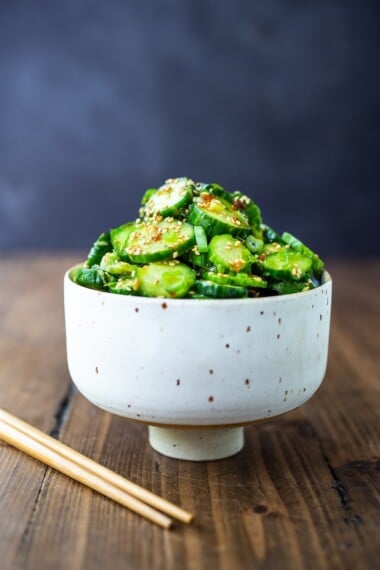
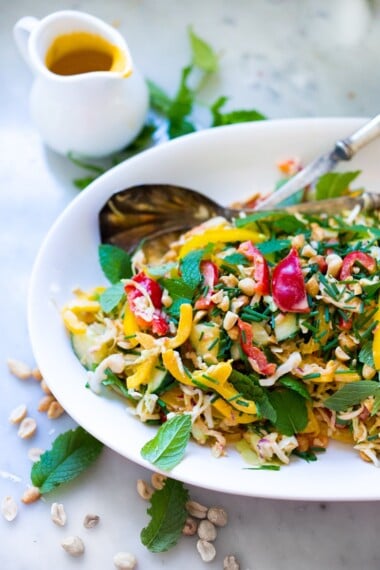
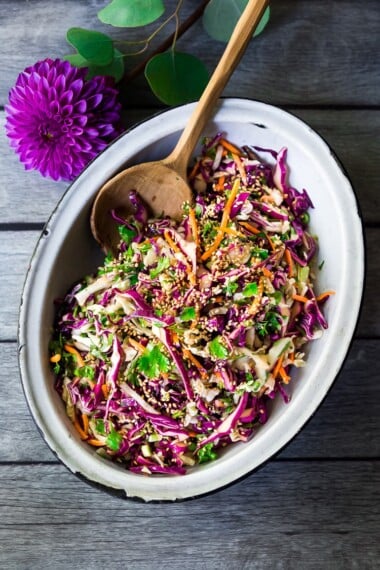
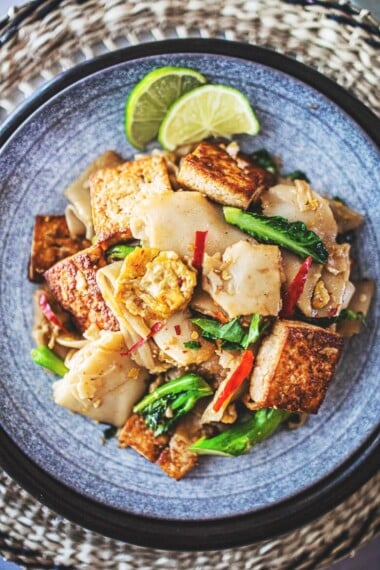
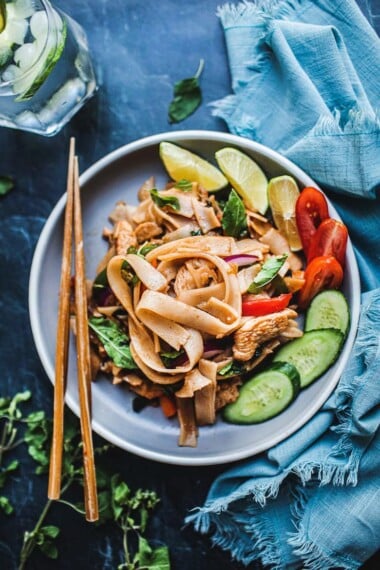
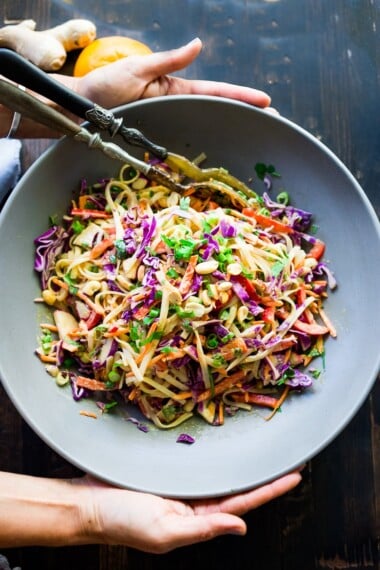
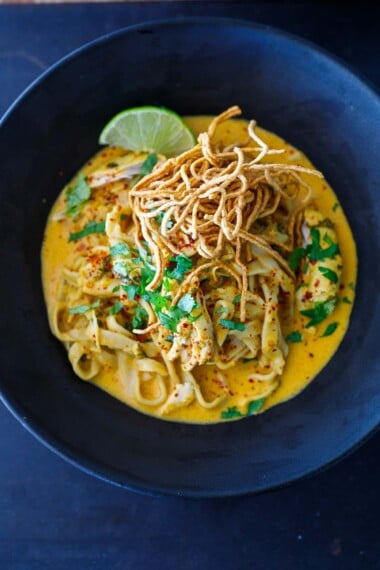
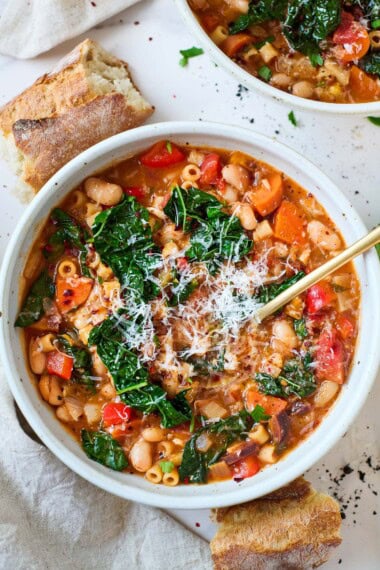
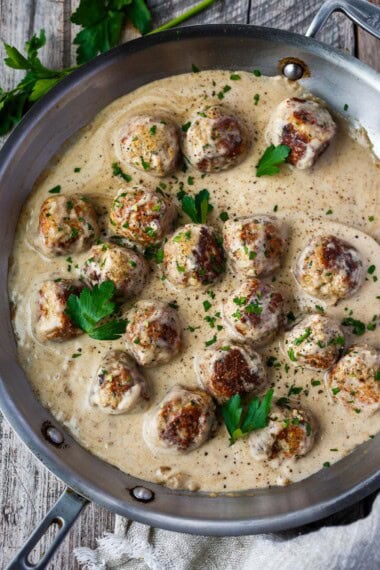
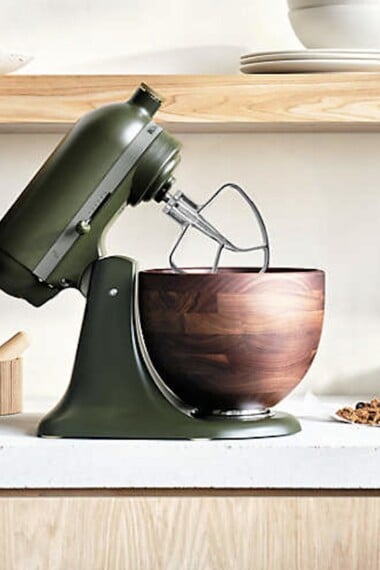
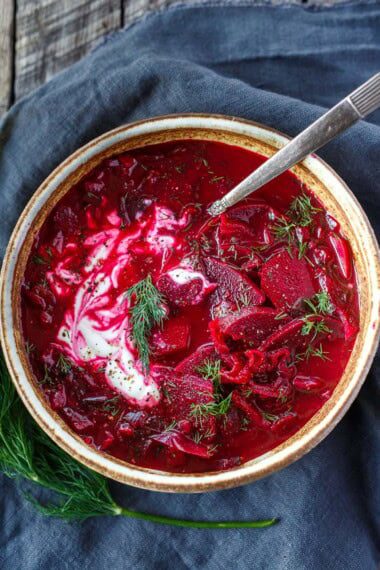


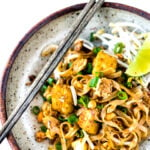
This recipe is the absolute BEST! I love it so much, I make it every month at the least! I love Thai food and it’s the closest I’ve ever got to replicating my fave Thai restaurants, if anything it’s just a little less greasy, so that’s a win!
Was in Thailand again two months ago and it’s so good to have a recipe I can make at home that tastes similar. Couldn’t believe how close it tasted to the real deal. Where I was in Thailand they seemed to have bits of carrot in as well so I added them in when I added the chicken and it tasted good. I must have used a extra salty fish sauce brand because it was a bit salty.. so will reduce salt for me next time. Thank you so much for the recipe!!
TEN STARS. Seriously- you gotta make this.
I was disappointed in the results of this recipe. I followed the directions exactly using the tamarind option. My results were quite tangy, very salty, and REALLY dark brown, with far too much sauce. It’s not even close to the Pad Thai I’ve had in several different restaurants. If I make it again, I’ll cut the tamarind in half and omit the soy (at the very least).
I’m sorry about that. To me, it sounds like you didn’t have enough noodles for the all the sauce.
We make this all the time and I swear it’s the best recipe out there- could you have mismeasured? We’ve done it with the tamarind water and the vinegar- both ways turned out balanced.
My favorite recipe for Pad Thai- we make this all the time. Thanks for sharing.
It was so delicious and easy to make – better than from my favorite Thai restaurant!
Thank you for this recipe! I’ve made it twice this week. First time I added too much chilli and it was too hot for my daughter (my bad not the recipe!) so I made it tonight for my daughter with no chilli. She loved it. Thanks!
Amazing flavor and simple recipe! Thanks!
Thanks Allison! Glad you liked this!
Looks delicious! I’m cooking this for our family of 4 tonight. I don’t have peanut oil, but noticed some recipes add 2 tbsp of peanut butter instead. Do you know if this would work?
I would use vegetable oil.
Was amazing. Thank you so much!!
My hubby and I loved it! I’ve had this recipe bookmarked since the beginning of the pandemic. The sauce was a perfect balance even though my husband thought it looked like there wasn’t enough sauce. After tasting it we were very impressed! I made it with boneless sliced chicken thighs and added slivered red peppers. Next time I’ll make sure to buy fresh coriander and crushed peanuts.
Can’t wait to make it again 🙂
Absolutely delicious!
I have a family of 6 to feed. How would you recommend I make this?
Prep for six. Cook 2 portions at a time- for best results.
Hi! I’m allergic to soy sauce and any other replacement for soy sauce. Since it’s a small portion of the recipe, could I leave it out?
Yes, you may need to add salt to taste.
My 1st time making Pad Thai following your recipe and it was soo delicious ! Thanks for the step by step you described, really helpful! Love it !
I have not tried this yet but how many people can this serve?
2
So good! Thank you 🙂
Far too fishy. The recipe calls for too much fish sauce. I was skeptical about the amount I was adding to increase the yield and I should have listened to my gut. The vinegar was quite strong as well. I wouldn’t recommend anyone follow this recipe to the letter. If it feels like it’s too much, it probably is.
Hi Michael, it could have been the brand of fish sauce- sorry about that.
What kind would you recommend
Red Boat, Taste of Thai or 3 Crabs
YES. It really is the best. And I’m Thai!
Fantastic! Every member of my family loved it. Your pad thai sauce is so simple
and so delicious. My noodles also broke into little pieces. After preparing them, I kept them in cold water (per package directions) while I prepped everything else. Perhaps that was the problem?
Feasting at Home has been a cherished friend during this pandemic. We love the recipes. I’m working my way through them one by one. Easy, healthy, and so flavorful. Thank you!
So glad you enjoyed!
This is my first time making pad thai (and on your blog) – it was amazing! It satisfied my pregnancy cravings (no doubt it’ll feature on the menu throughout the week). Thank you so much for sharing this version.
This was a really great recipe- will definitely be making this again!
I was so very excited to make this, and was literally in the middle of it when I realized I must have forgotten to buy rice wine vinegar. I Googled replacements and it said to use white wine vinegar but to add a bit of sugar. I thought maybe since there was brown sugar in the recipe anyway it would be fine. Well. I was wrong. Tasted quite strong of vinegar. So, I added more brown sugar. It helped, but didn’t fix it. I was rather disappointed, but maybe results would have been better if I had the proper vinegar.
Oh dear. Ya, that probably wouldn’t taste very good. Sorry about that. Rice wine vinegar is less “vinegary”.
Perhaps she had the issue i had, which is that when you read through it the instructions apparently shorten rice wine vinegar to rice vinegar – but further down when the specific amounts for the ingredients are listed, it says rice wine vinegar. So you actually need rice wine vinegar and not rice vinegar, correct??
I use them interchangeably. Are they different? I always thought they were the same.
Loved the sauce! Simple yet balanced. The process was great too though with prep I was at 45 minutes at least. The one problem I had was with the quantity of noodles. From the pic it looks like a full package yet the recipe calls for 3-4 oz. Our standard packages are 12-14 oz. Watching the video it didn’t look like it was cooking only a quarter of what I was. Problem was we did not end up with enough sauce. A serving of 3-4 oz seems like an individual serving quantity.
Hi Stephanie, one serving of dry noodles is 2 ounces. So use 4 ounces for 2 servings which is the perfect amount of noodles for the sauce. Cooking any more than this ( or doubling the recipe) crowds the pan too much and it’s just not as good.
I often just soften all the noodles in the package, and use the remainder for other things, or another batch the next day.
Do you add the juice of 1/2 lime juice in the pad Thai sauce? I did and it was a bit sharp…
Also my noodles broke into small bits 😒
Hummm, not sure about your noodles, were they overly soft? I normally use half a small lime, but sometimes limes if not ripe can be overly acidic.